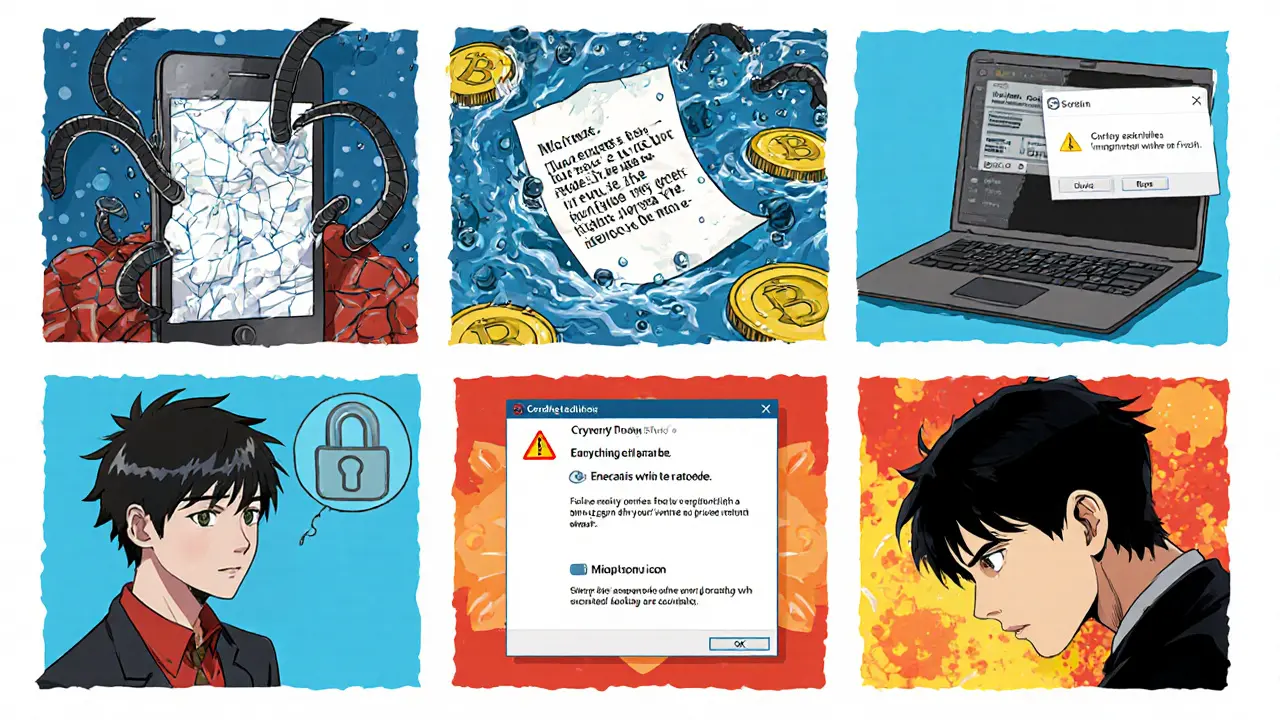Every year, headlines scream about someone losing a fortune because a simple slip‑up with their seed phrase wiped out their crypto holdings. The numbers are staggering - a 2024 Shieldfolio report found that 78% of loss incidents traced back to poor seed phrase handling. If you own any digital assets, those stats should make you sit up and pay attention.
What exactly is a seed phrase?
Seed phrase is a human‑readable sequence of 12 or 24 words generated when you create a crypto wallet. It serves as the master key that can reconstruct every private key inside the wallet, letting you recover funds on any compatible device. The phrase follows the BIP‑39 standard - a protocol defined in 2013 that maps each word to an 11‑bit chunk of entropy, creating a cryptographically secure seed.
Why mishandling a seed phrase is a disaster
Unlike a bank password, a seed phrase has no "forgot my password" option. It’s the only thing standing between you and your coins. Blockplate’s 2023 analysis showed a 12‑word phrase offers 2^128 possible combinations - essentially uncrackable - but only if it stays secret and intact. When the phrase is exposed, lost, or corrupted, the assets become permanently inaccessible.
Six common mistakes that cause most seed phrase losses
- Storing the phrase digitally without strong encryption. Rockwallet’s 2023 penetration test revealed that unprotected screenshots or text files can be harvested by malware within 72 hours. Even popular password managers become a single point of failure, as Dr. Emily Parker warned at Black Hat 2024.
- Using paper that degrades. Standard printer paper breaks down after about three years under normal humidity, according to Blockstream’s accelerated aging tests. When ink fades or the paper tears, the phrase can become unreadable forever.
- Skipping a test restore. Jade Wallet’s field study found 67% of new users never try to recover their seed on a fresh device. The result? Hidden transcription errors surface only when you actually need the funds.
- Generating the phrase on an online device. A Blockplate honeypot experiment showed a 12.9× higher compromise rate when the seed was created on a phone or laptop connected to the internet.
- Getting the word order wrong. RecoverySeed.cz documented that swapping just two words creates a valid but entirely different wallet, leading to a 23.8% failure rate in recovery attempts.
- Sharing the seed with anyone. Chainalysis’ 2023 incident report linked 83.1% of compromised wallets to owners who showed the phrase to family, friends, or “support” callers.
How to avoid each mistake - a practical checklist
- Generate the seed on an air‑gapped device (e.g., a hardware wallet that never connects to the internet during creation).
- Write the phrase on a durable medium - stainless‑steel plates have survived salt spray for 500 hours and temperatures over 1,200 °C (Blockplate 2024).
- Store the metal backup in a fire‑proof, waterproof safe and keep a second copy in a separate location (e.g., a safety deposit box).
- Never keep a digital copy unless it’s encrypted with at least AES‑256 and stored offline.
- Perform a test restore on a fresh wallet with a tiny amount of crypto (0.001 BTC is a common recommendation).
- Use a unique passphrase (the 13th/25th word) only if you can reliably record it elsewhere - otherwise you create a second point of failure.
- Consider a multisignature setup for high‑value holdings, distributing control across multiple devices or trusted parties.

Durable storage showdown - paper vs. metal
| Medium | Longevity (years) | Resistance to fire | Resistance to water | Cost (USD) |
|---|---|---|---|---|
| Standard printer paper | ~3 | Low | Low | 0.10 |
| Cold‑laminated cardstock | ~10 | Medium | Medium | 2‑5 |
| Stainless‑steel plate | 500+ | High | High | 15‑30 |
| Titanium alloy | ~200 | High | High | 20‑35 |
For most users, a stainless‑steel backup offers the best peace of mind without breaking the bank. The upfront cost is small compared to the potential loss of thousands of dollars.
Step‑by‑step: Verifying your seed phrase correctly
- Write down the 12 (or 24) words exactly as they appear in the wallet UI. Use a black‑ink ballpoint pen on a non‑glossy surface.
- Check the checksum - the last word in a 12‑word phrase validates the preceding 11. If the wallet warns of an invalid checksum, you’ve mistyped.
- Transfer the written phrase onto a stainless‑steel plate using the supplied engraving tool. Verify each character before stamping.
- Store the plate in a fire‑proof safe. Record the safe’s location in a secure, encrypted note that does not contain the seed itself.
- After a week, perform a restore on a fresh hardware wallet using only the plate. Send a tiny transaction to confirm you control the funds.
Repeating this check annually is a habit that catches degradation or accidental damage before disaster strikes.
Advanced protection: Combining passphrases and multisig
For users with significant holdings, adding a passphrase (sometimes called the 13th/25th word) creates a completely separate seed tree. This means even if the base phrase is exposed, the assets behind the passphrase stay locked away. However, RecoverySeed.cz found that 34.8% of people who add a passphrase forget where they stored it, leading to total loss. The rule of thumb: only use a passphrase if you can keep it offline in a separate, equally durable form.
Multisignature wallets distribute control across several keys. Unchained Capital’s 2024 data shows a 3‑of‑5 setup cuts single‑point failure risk by 99.97%. Each co‑signer can hold its own seed phrase on a different metal backup, making a single breach far less catastrophic.

Common myths that fuel mistakes
- Myth: "Password managers are safe for seed phrases." Fact: They become a single target; a breach opens every wallet you own.
- Myth: "I can just memorize the phrase." Fact: Human memory reliably stores 7±2 items; recalling 24 random words under stress is near impossible (Andreas Antonopoulos, 2023).
- Myty: "A photo on my phone is fine as long as I lock it." Fact: SIM‑swap attacks can give thieves full phone control, exposing any saved images instantly.
Quick cheat‑sheet: Do’s and don’ts
| Do | Don’t |
|---|---|
| Generate seed on an air‑gapped hardware wallet. | Write the seed on a sticky note and leave it on a desk. |
| Back up on stainless‑steel plates stored in separate safes. | Save a screenshot of the seed in iCloud or Google Drive. |
| Test restore with a tiny amount of crypto before loading larger sums. | Assume the seed works because the wallet displayed it. |
| Use a unique passphrase only if you can store it securely. | Share the phrase with “trusted” friends or family. |
Bottom line
When you control your own crypto, the seed phrase is the ultimate master key. Treat it like a vault combination: generate it safely, back it up on durable media, verify it regularly, and never let anyone else see it. Following the checklist above can cut your risk of loss from the industry‑average 78% down to single‑digit levels.
Can I store my seed phrase on a hardware wallet instead of paper?
No. The wallet only holds the seed for recovery; it does not act as a backup. If the device fails or is lost, you need a separate physical copy of the phrase.
Is a 12‑word seed as secure as a 24‑word one?
A 12‑word seed provides 128‑bit security, which is still considered strong. However, a 24‑word seed offers 256‑bit security, making it future‑proof against advances in computing.
How often should I test my seed phrase?
At least once a year, or whenever you add a new backup medium. A quick restore with a nominal amount of crypto confirms the backup is still legible.
What’s the best metal for a seed phrase backup?
Stainless steel is the most popular due to its corrosion resistance and ability to survive extreme heat. Titanium is also strong but can warp at lower temperatures.
Can a passphrase be used with any wallet?
Only wallets that support BIP‑39 extensions can use a passphrase. Check the wallet’s documentation before relying on it.


Post Comments (1)
Alright, let’s break this down, step by step, because apparently most people need a bedtime story to understand why a seed phrase isn’t a souvenir you stick on your fridge. First, the seed phrase is the master key, the only thing that can resurrect a wallet, so treat it like the nuclear launch codes, not a Post‑it note. Second, never, ever generate it on a device that has ever seen the internet – an air‑gapped hardware wallet is the only sane choice. Third, once you have the phrase, write it down using a ball‑point pen on a non‑glossy surface, because cheap gel pens bleed and ruin legibility. Fourth, transfer that paper copy onto a stainless‑steel plate; the metal will survive fire, flood, and a toddler’s curiosity. Fifth, store the metal backup in a fire‑proof safe, and keep a second copy in a geographically separate location – think safety‑deposit box, not under your mattress. Sixth, encrypt any digital backup with at least AES‑256, and keep it offline, because password managers are single points of failure. Seventh, perform a test restore with a tiny amount of crypto – 0.001 BTC is enough to confirm everything works without risking a fortune. Eighth, consider adding a passphrase only if you can store that passphrase on another durable medium; otherwise you’ve just added another hidden lock you’ll forget. Ninth, for large holdings, adopt a multisignature scheme – a 3‑of‑5 setup reduces risk dramatically. Tenth, check the checksum of your phrase; the last word validates the preceding eleven, and a mismatch is a clear sign of a typo. Eleventh, repeat the verification annually, because paper fades and metal can warp over time. Twelfth, never share the phrase with anyone, not even ‘trusted’ friends; social engineering is the most common vector for theft. Thirteenth, remember that a 12‑word seed gives you 128‑bit security – still astronomically strong – but a 24‑word seed future‑proofs you against quantum advances. Fourteenth, if you’re feeling extra cautious, split the phrase across two different mediums, but keep notes on where each piece lives. Fifteenth, finally, sleep soundly knowing you’ve covered every obvious pitfall, because ignorance is the only thing that can still get you robbed. In short, treat your seed phrase like a priceless heirloom: write it, engrave it, duplicate it, test it, and never, ever let anyone else touch it.